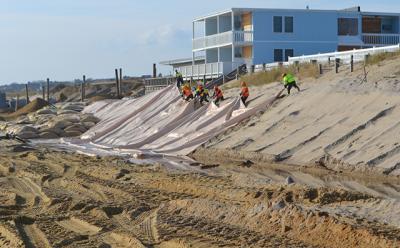No Parking by Preserve
No Parking by Preserve
Over objections from members of its nature preserve committee, the East Hampton Town Board last Thursday adopted an altered management plan for the South Flora preserve on Napeague, omitting parking along the preserve.
Parking had been a topic of contention and discussion at numerous town meetings. Residents of Dolphin Drive and nearby streets vehemently opposed it, citing safety concerns. Others, demanding public access to the preserve and its adjacent beach, accused them of trying to privatize the area.
The altered management plan designates a road-end beach parking area at Atlantic Drive, several blocks away from the preserve, as its parking lot. “It’s 800 feet away; that’s almost three football fields,” said Reg Cornelia, a member of the nature preserve committee, at a town board meeting last Thursday. “That’s like saying parking for the Atlantic Avenue beach should be at Indian Wells.” He asked the board not to vote on the management plan until it could be further discussed. “My name is on this thing,” he said. “If you vote on it tonight I want you to take my name off it.”
Diane McNally, the clerk of the East Hampton Town Trustees, agreed. Ms. McNally, who represented the trustees on the preserve committee, said the committee’s draft plan, after being circulated to the town’s Natural Resources, Planning, and Land Acquisition Departments, had been revised in a number of ways.
“There’s no significant access to this nature preserve,” she said.
Among the changes, said Mr. Cornelia, a reference to the land as an access to a “public bathing beach” had been omitted, as had mention of a bond that would have paid for the creation of parking.
The town bought the property in 2000 for preservation of open space and possible public recreational use as an ocean bathing beach. Since then, residents of the nearby area, particularly of Dolphin Drive, which abuts the western side of the preserve, have lobbied hard, and sued the town, to prevent parking along the adjacent streets. In May, the town board agreed to ban parking on both sides of Dolphin Drive.
The board approved the new plan last Thursday by a 3-to-1 vote. Councilman Fred Overton voted against it, suggesting that the nature preserve committee be allowed to weigh in on the final version. Councilwoman Kathee Burke-Gonzalez was absent. Councilman Peter Van Scoyoc said that adopting it did not preclude adding a parking area in the future.
Conditions at the Y.M.C.A. East Hampton RECenter pool were the subject of comments by another group of speakers that evening. Parents whose children swim there told the board that students and swim team members have experienced negative health effects after spending time in the pool. “It is probably just as much about the water quality as about air quality,” Alex de Havenon said.
“We share your concerns,” Supervisor Larry Cantwell answered. Engineers have already been selected and inspections begun to determine what repairs and maintenance are needed, he said, noting that a bond resolution to raise $750,000 for the needed work was on the board’s agenda later that night. The resolution was approved.
Michael Forst urged the board not only to proceed with the repairs but to consider installing another pool at the facility.
A pool pump motor and strainer were repaired in 2012 after complaints about sanitation and safety; additional work on pool filters was done in September. L.K. McLean Associates, an engineering firm, was hired earlier this month to oversee replacement of the building’s dehumidification, heating, and water systems. The 17-year-old building is owned by the town but leased to the Y.M.C.A.
With another vote last Thursday, the town board approved a “selective hunting” pilot program suggested by its deer management advisory committee. Under the program, town-approved bow hunters will be allowed to hunt on town properties not open to general hunting. The sites include land north of the Montauk recycling center, the old Bull Path brush dump in East Hampton, and the Brooks-Park and Hach properties in Springs.
The prospect of increased hunting has been strongly opposed by members of the East Hampton Group for Wildlife and others who have questioned the need for herd reduction and urged the town to accrue more data on the impact of deer before proceeding.
“Preserve our town land as respites for our wildlife families,” said Betsy Petroskey at last week’s meeting.
Finally, the board voted to use the community preservation fund to add new lands to the public holdings. A .15-acre lot owned by Gaetano and Allison Lupo at 2 Harbor Boulevard in Springs, near Maidstone Park, will be purchased for $735,000. Several cottages on the property will be torn down at the owners’ expense. The site is close to tidal wetlands, in a harbor protection district, and in state scenic and fish and wildlife habitat areas, said Scott Wilson, the town’s director of land acquisition.
The board also voted to purchase a half acre at 185 Old Montauk Highway in Amagansett from William and Kathleen Denice for $500,000, for open space.




